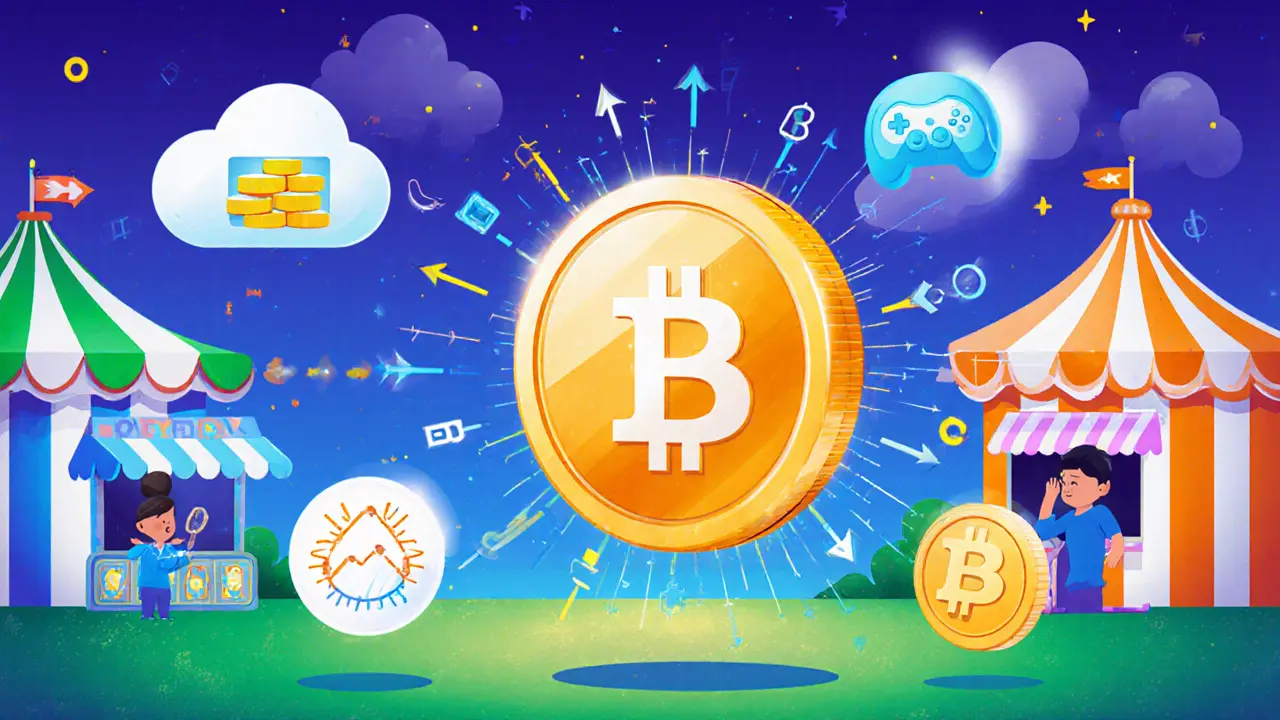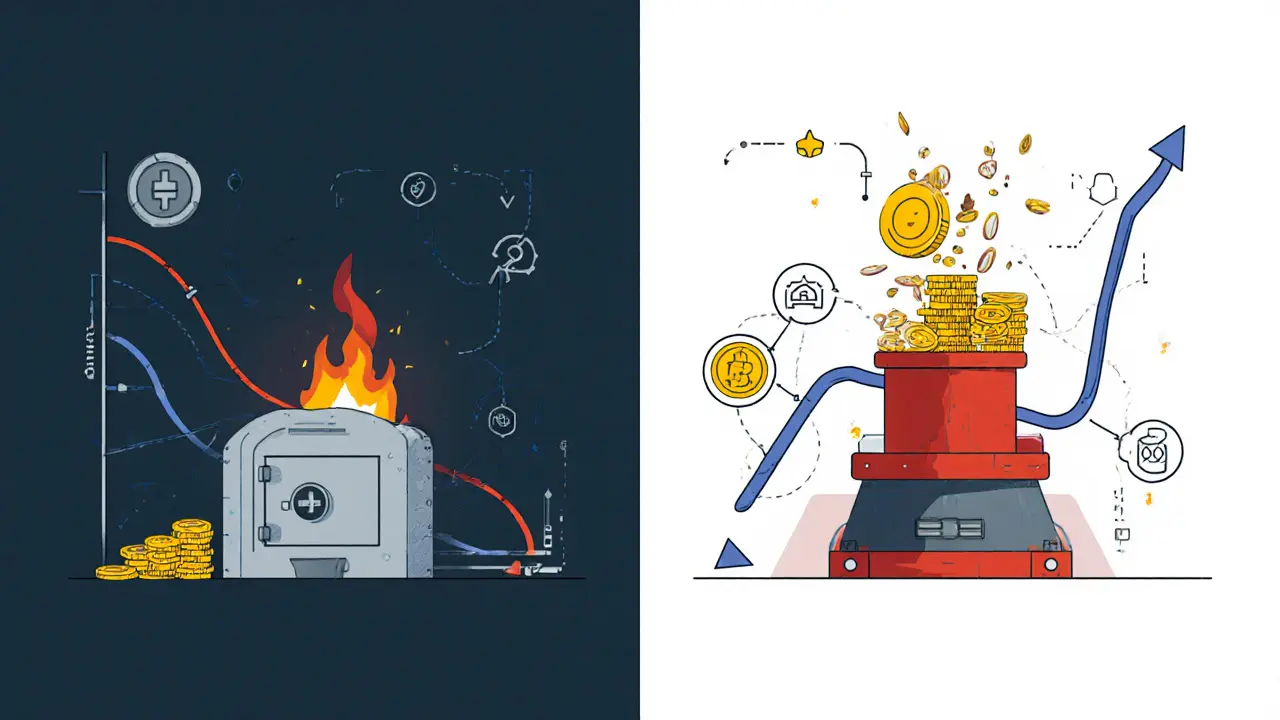Investing in Platform Tokens: Opportunities & Risks

Platform Token Investment Analyzer
Overall Score: 50
Based on your inputs, this platform token shows moderate potential. Consider reviewing tokenomics and liquidity before investing.
Allocate no more than 5-10% of your crypto portfolio to any single platform token.
| Attribute | Fixed Supply | Inflationary Supply |
|---|---|---|
| Typical Use-Case | Store-of-value, scarcity-driven projects | Platform growth, staking rewards |
| Price Pressure | Upward pressure as demand rises | Potential dilution if inflation exceeds demand |
| Investor Signal | Clear scarcity → easier valuation | Dynamic supply → requires monitoring of inflation schedule |
| Examples | Basic Attention Token (BAT), Chainlink (LINK) | Ethereum (ETH) post-EIP-1559, Polygon (MATIC) |
When you hear the term platform tokens, you might picture a new breed of crypto that sits between everyday coins like Bitcoin and niche utility assets. These tokens act as the fuel that powers specific digital services, much like buying tokens at a carnival to ride the attractions you want. Understanding why they matter, how they generate value, and what risks they carry can turn a vague curiosity into a concrete investment strategy.
What exactly is a platform token?
Platform token is a fungible digital asset that grants users access to services, products, or governance rights within a particular blockchain‑based ecosystem. Unlike pure cryptocurrencies that primarily serve as money or a store of value, platform tokens are tied to the health and usage of the platform they belong to.
How do platform tokens differ from other crypto assets?
Two other token families help illustrate the distinction:
- Utility token provides a specific function-such as paying for API calls or unlocking premium features-within a blockchain product
- Security token represents ownership in an underlying asset, like equity or real‑estate, and is subject to securities regulation
Platform tokens are a subset of utility tokens but earn a unique status because they often become the native currency for a whole ecosystem. Think of them as the “dollar” of a decentralized app (dApp) rather than a token you only use for one feature.
The technical backbone: ERC‑20 and beyond
The surge of platform tokens began with the ERC‑20 standard introduced on Ethereum in 2015 that lets developers launch fungible tokens on an existing blockchain without building a new network. ERC‑20 lowered development costs, accelerated launch timelines, and gave investors a familiar contract interface to evaluate.
Today, newer standards like ERC‑777 and ERC‑1155 add features such as built‑in transaction hooks or hybrid fungible/NFT capabilities, but the core idea remains: a token is a piece of code that can be bought, sold, and used within a smart‑contract‑driven platform.
Why platform tokens can be attractive investments
Three main forces drive value:
- Utility‑derived demand. As users consume services-paying for cloud storage, gaming credits, or decentralized finance (DeFi) yields-they must hold the native token, creating a baseline demand curve.
- Network effects. More users = more transactions = higher token velocity, which often translates into price appreciation when supply is limited.
- Revenue‑sharing models. Some platforms allocate a portion of fees or profits back to token holders, effectively turning the token into a dividend‑paying asset.
When these forces align, token price can grow faster than traditional equities, especially in early‑stage ecosystems where adoption is still accelerating.

Key investment considerations
Before you allocate capital, run through this checklist:
- Platform fundamentals. Is the product solving a real problem? Look for demo videos, developer activity on GitHub, and partnerships with established firms.
- Tokenomics. Examine total supply, inflation rate, and token burn mechanisms. A fixed supply often creates scarcity, while controlled inflation can fund ecosystem growth.
- Liquidity. Tokens listed on multiple reputable exchanges (e.g., Binance, Kraken) generally offer tighter spreads and easier exit strategies.
- Regulatory outlook. Tokens that qualify as securities may face stricter compliance; consult the Regulation framework overseeing token issuance, trading, and investor protection in various jurisdictions.
- Governance model. Decentralized platforms often rely on token‑based voting. Review proposal histories to gauge community engagement.
Supply structures: Fixed vs. inflationary
| Attribute | Fixed Supply | Inflationary Supply |
|---|---|---|
| Typical Use‑Case | Store‑of‑value, scarcity‑driven projects | Platform growth, staking rewards |
| Price Pressure | Upward pressure as demand rises | Potential dilution if inflation exceeds demand |
| Investor Signal | Clear scarcity → easier valuation | Dynamic supply → requires monitoring of inflation schedule |
| Examples | Basic Attention Token (BAT), Chainlink (LINK) | Ethereum (ETH) post‑EIP‑1559, Polygon (MATIC) |
Risks you can’t ignore
Platform tokens carry a distinct risk profile. The biggest red flags are:
- Platform‑specific failure. If the underlying service can’t attract users, token demand evaporates.
- Security breaches. Smart‑contract bugs or hacks can wipe out token value overnight.
- Regulatory clamp‑down. A shift in Initial Coin Offering fundraising event where new tokens are sold to early investors rules could force token delistings or retroactive penalties.
- Governance gridlock. Decentralized voting may stall upgrades, leaving the platform exposed to technical debt.
- Liquidity crunch. Some tokens trade only on niche DEXs, leading to high slippage for sizeable orders.
Mitigation strategies include diversifying across multiple platforms, staking only a portion of your portfolio, and staying current on security audits and regulatory news.
How to evaluate a platform token - a step‑by‑step guide
- Read the whitepaper. Identify the problem statement, target market, and token utility.
- Check the development roadmap. Look for quarterly milestones and delivered features on GitHub.
- Analyze tokenomics. Record total supply, release schedule, burn rate, and staking rewards.
- Assess market data. Review 30‑day volume, exchange listings, and order‑book depth.
- Review regulatory exposure. Determine whether the token is classified as a security in major jurisdictions.
- Test the product. If possible, use a small amount of the token on the platform to gauge user experience.
- Decide on position size. Allocate no more than 5‑10% of your crypto exposure to any single platform token.
Future outlook - where the market may be heading
Three trends could amplify the investment case for platform tokens over the next five years:
- Enterprise tokenization. Large corporations are piloting token‑based supply‑chain tracking, creating demand for industry‑specific tokens.
- Regulatory clarity. As jurisdictions settle on definitions for utility versus security tokens, compliance costs will drop and institutional participation will rise.
- Interoperability layers. Protocols like Polkadot and Cosmos enable tokens from different ecosystems to work together, expanding the addressable user base.
Investors who spot platforms with solid fundamentals early can capture upside as these macro forces unfold.

Frequently Asked Questions
What is the main difference between a platform token and a regular cryptocurrency?
A platform token’s value is tied to a specific service or ecosystem, whereas a regular cryptocurrency like Bitcoin derives most of its price from broader market speculation and store‑of‑value perception.
How can I tell if a token is inflationary?
Check the token’s smart‑contract or whitepaper for a minting schedule. If new tokens are created regularly to reward validators or fund development, the token is inflationary.
Are platform tokens regulated like securities?
Regulation varies by jurisdiction. Tokens that grant profit‑sharing rights or represent ownership can be classified as securities, subjecting them to stricter compliance rules.
What’s a good way to diversify my platform‑token exposure?
Spread investments across different verticals-gaming, DeFi, supply‑chain, and data‑marketplaces-while keeping each position under 10% of your total crypto allocation.
How important is token liquidity for an investor?
Very important. High liquidity means you can enter or exit a position with minimal price impact and lower risk of being stuck on an ill‑traded token.

14 Comments
Hey, I get why the token‑economics section feels a bit vague – it can be tough to separate hype from real utility.
What really helps is to check the actual on‑chain activity; if the volume is growing, that’s a good sign of organic demand.
Also, try chatting with the community on Discord or Telegram to see if developers are responsive.
Remember to keep any single token allocation under 10 % of your whole crypto portfolio.
Staying diversified will make the inevitable ups and downs feel a lot less stressful.
The protocol’s tokenomics schema appears to be a classic case of inflationary supply coupled with a vesting curve that is ostensibly aligned with validator incentive structures, yet the whitepaper fails to divulge the precise mint‑rate parameters, which raises concerns regarding model drift in the long‑term equilibrium state.
When evaluating platform tokens, it’s essential to consider, first, the underlying utility, second, the governance mechanisms, third, the liquidity depth, and finally, the regulatory jurisdiction in which the token operates.
One might view a platform token not merely as a financial instrument, but as a digital embodiment of collective trust, a ledger of collaborative intent.
In this sense, its value is inseparable from the health of the community that sustains it.
Thus, assessing developer commitment and user adoption becomes a moral inquiry as much as an economic one.
When these elements align, the token can transcend speculative volatility.
Honestly, I think evryone’s overblowing the risk – sure, there’s a chance of a hack, but that’s true for any software product.
Don’t let the hype scare you away from a potentially lucrative stake.
I’ve been looking at a few platforms where the token is used for staking rewards, and the data shows a steady increase in staked volume over the past quarter.
That suggests the incentives are working and the community is staying engaged.
If you’re comfortable, allocating a modest amount-say, 5 % of your crypto exposure-could let you benefit from the upside without overexposing yourself.
Platform tokens occupy a unique niche between pure currencies and utility tokens, offering both transactional utility and governance rights.
This dual function creates a demand curve that can be more resilient than that of a single‑purpose coin.
However, resilience is not guaranteed; it hinges on actual product adoption and the network’s ability to retain users.
First, examine the problem the platform claims to solve-does it address a real market inefficiency?
Second, scrutinize the development activity on repositories like GitHub to gauge ongoing commitment.
Third, evaluate the token’s supply schedule: a fixed cap can generate scarcity, while a controlled inflation model may fund growth but risks dilution.
Fourth, look at where the token trades; listings on reputable exchanges usually mean better liquidity and tighter spreads.
Fifth, assess the governance model-are proposals voted on transparently, and does the community have meaningful influence?
Sixth, check for any revenue‑sharing mechanisms that could provide a token‑holder dividend, which adds a layer of practical value.
Seventh, keep an eye on regulatory developments in the jurisdictions where the platform operates, as a shift in classification can affect market access.
Eighth, consider the broader ecosystem-does the platform integrate with interoperable protocols like Polkadot or Cosmos, expanding its addressable market?
Ninth, monitor security audits; a recent audit with few critical findings is a good sign, whereas a history of exploits is a red flag.
Tenth, diversify across verticals; allocating a little to gaming, a little to DeFi, and a little to data marketplaces spreads risk.
Finally, set a hard cap on exposure-most experts advise no more than 5‑10 % of your total crypto portfolio in any single platform token.
By following this checklist, you can convert hype into a disciplined investment strategy that balances upside potential with downside protection.
It is rather elementary to observe that the ostensible decentralization narratives propagated by many token projects merely veil a covert orchestration of market manipulation, a phenomenon that becomes apparent when one triangulates on‑chain flow data with off‑chain lobbying disclosures.
I think the best approach is to treat platform tokens like any other asset class: do your homework, keep the allocation modest, and stay aware of news that could affect the underlying platform.
People keep shouting “don’t invest in inflationary tokens,” but honestly the staking incentives on many of these chains can offset dilution if you lock up the right amount at the right time.
Meh, the tokenomics look fine, not much to say.
It’s disconcerting how many investors blindly chase platform tokens without questioning whether the projects are merely serving as financial conduits for shadowy entities; one must remain vigilant and demand full transparency to avoid being complicit in a larger scheme.
Oh great, another token to lose money on.
In conclusion, while platform tokens present undeniable opportunities, a judicious allocation-anchored by thorough due diligence and an optimistic yet realistic outlook-will serve prudent investors well in navigating this evolving landscape.